
Fr: Canard musqué
All : Moschusente
Esp : Pato Criollo
Ital: Anatra muta
Nd: Muskuseend
Sd: Myskand
Port: Pato-do-mato
Photographers:
Marc Chrétien
MURINUS
Patrick Ingremeau
TAMANDUA
Photos de Philippe et Aline Wolfer
OISEAUX D’ARGENTINE
Nicole Bouglouan
PHOTOGRAPHIC RAMBLE
Texte de Nicole Bouglouan
Sources:
HANDBOOK OF THE BIRDS OF THE WORLD vol 1 by Josep del Hoyo-Andrew Elliot-Jordi Sargatal - Lynx Edicions - ISBN: 8487334105
L’ENCYCLOPEDIE MONDIALE DES OISEAUX - Dr Christopher M. Perrins - BORDAS - ISBN: 2040185607
GUIDE DES CANARDS, DES OIES ET DES CYGNES – de Steve Madge - Delachaux et Niestlé - ISBN: 2603013769
El Zoológico Electrónico (Damisela)
What Bird-The ultimate Bird Guide (Mitchell Waite)
Wikipedia (Wikipedia, The Free Encyclopedia)
Muscovy Duck
Cairina moschata
Anseriforme Order – Anatidae Family
BIOMETRICS:
Length: 66-84 cm
Wingspan: 137-152 cm
Weight: 1100-4000 g (wild bird)
DESCRIPTION:
The Muscovy Duck is a large duck living in Central and South America.
The wild species is more slender than the domesticated birds which can reach up to 5000-8000 gr.
Adult (wild bird) has black plumage with conspicuous white wing patch, and green metallic gloss on the upperwing. The white patch varies according to the age.
On the head, the male has short crest on the nape. The bill is black, spotted pale pink. We can see a blackish or dark red knob at the bill base, and the bare skin of the face is similar in colour. Eyes are yellowish-brown. Legs and webbed feet are blacksih.
The female is similar in plumage, but smaller than male, and she has feathered face and lacks the knob.
The juvenile is duller overall, with little or no white on the upperwing.

The domesticated birds look similar but usually, they have dark brown or black and white plumage. Some of them can be all-white.
They have more knobs on the face and these ornaments are mostly red. Eyes are darker.
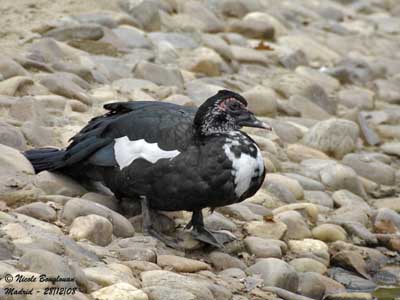
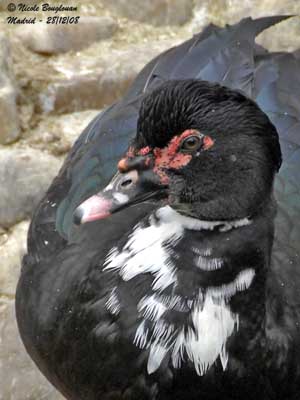
VOICE: SOUNDS BY XENO-CANTO
The Muscovy Duck is mostly silent, but we can hear a low whistle from the male, while the female utters short, guttural, weak cackles.
HABITAT:
The Muscovy Duck frequents the wooded tropical wetlands at low elevation. It can be seen in coastal lagoons and marshes in dry season.
It breeds close to the slow-flowing streams and prefers freshwater.
RANGE:
The Muscovy Duck is found in Tropical America, from Mexico, S to E Peru and N Uruguay.
BEHAVIOUR:
The Muscovy Duck feeds on plant matter and animal food (invertebrates and small vertebrates).
This large duck feeds by dabbling and upending, mainly in shallow water. When on land, it grazes, walking slowly on the ground.
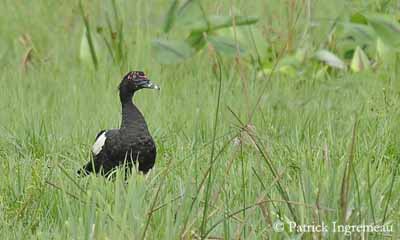
It is more active at dawn and dusk, and usually seen in small groups.
It perches and rests in trees, on large branches, in order to avoid the terrestrial predators. It is a wary bird. It often roosts in trees.
As in most of Anseriformes species, the male does not take part in nesting duties, and does not defend the nest-site.
But it can be aggressive when feeding, or in territory defence and during the breeding period. The pairs are not stable. Copulation occurs in the water or occasionally on the ground that is unusual in ducks.
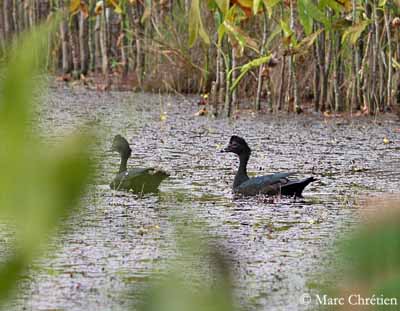
The Muscovy Duck is mainly sedentary, but local movements are associated to water levels during the dry season.
They leave the wooded areas when the savannahs are flooded, and during the dry season, they reach the brackish waters of coastal lagoons and marshes.
FLIGHT:
The Muscovy Duck performs strong, direct, laboured flight, and appears heavy when flying.
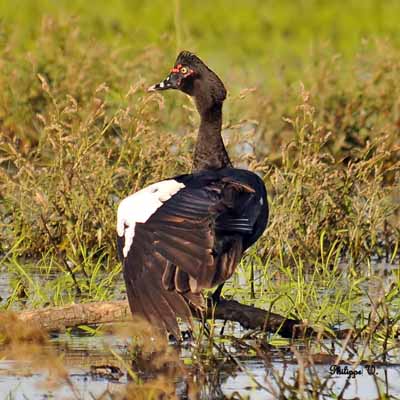
REPRODUCTION:
Breeding season occurs during the rainy period, but varies according to the range.
The Muscovy Duck breeds in single pair. The nest is placed in hole in tree or in cavity, occasionally on the ground, hidden in the thick vegetation of the shore. Some down can be added or not. Sometimes, abandoned raptors’ nests are used.
The female lays 8-15 white eggs washed greenish. Incubation lasts 35 days, by female alone. The male can be seen sometimes in the vicinity of the nest, but usually, the female cares and rears the young alone.
The chicks are precocial and leave the nest very soon, following their mother. They depend on her during several weeks for food and at night. At this moment, the male may provide some protection to the brood by walking in the surrounding of the family.
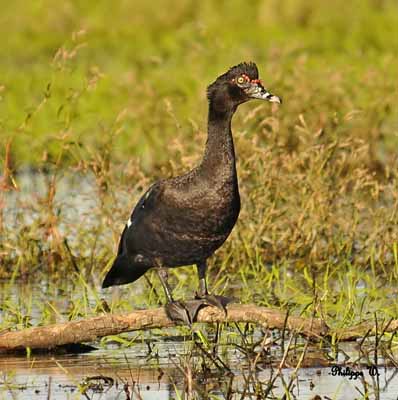
DIET:
The Muscovy Duck feeds on plant matter such as roots, seeds, stems and leaves of grasses, sedges and aquatic plants.
It also takes small vertebrates such as fish and reptiles, and invertebrates including various insects, spiders and crustaceans.
PROTECTION / THREATS / STATUS:
The Muscovy Duck is widespread in its range, but mainly locally common.
However, several declines have been observed due to hunting pressure, egg-collecting and habitat loss. Another threat for the wild species: the hybridization with domestic birds.
At this moment, the species is not threatened.
